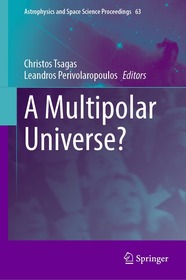
A Multipolar Universe?
Series: Astrophysics and Space Science Proceedings; 1;
- Publisher's listprice EUR 213.99
-
88 752 Ft (84 526 Ft + 5% VAT)
The price is estimated because at the time of ordering we do not know what conversion rates will apply to HUF / product currency when the book arrives. In case HUF is weaker, the price increases slightly, in case HUF is stronger, the price goes lower slightly.
- Discount 12% (cc. 10 650 Ft off)
- Discounted price 78 102 Ft (74 383 Ft + 5% VAT)
Subcribe now and take benefit of a favourable price.
Subscribe
88 752 Ft

Availability
printed on demand
Why don't you give exact delivery time?
Delivery time is estimated on our previous experiences. We give estimations only, because we order from outside Hungary, and the delivery time mainly depends on how quickly the publisher supplies the book. Faster or slower deliveries both happen, but we do our best to supply as quickly as possible.
Product details:
- Publisher Springer Nature Switzerland
- Date of Publication 19 June 2025
- Number of Volumes 1 pieces, Book
- ISBN 9783031855269
- Binding Hardback
- No. of pages280 pages
- Size 235x155 mm
- Language English
- Illustrations VIII, 280 p. 72 illus., 61 illus. in color. Illustrations, black & white 672
Categories
Long description:
This volume presents cutting-edge research on one of modern cosmology's most intriguing challenges: the observed dipolar anisotropies that appear to conflict with the standard ΛCDM cosmological model. Through its contributed chapters, the book extensively examines multiple lines of evidence suggesting directional preferences in various cosmological observations, from cosmic expansion to galaxy cluster distributions.
The work explores two fundamental possibilities: either these dipoles represent genuine spacetime anisotropy, challenging the cosmological principle itself, or they indicate a need to revise our interpretation of the cosmological data and the current models of large-scale structure formation. Both scenarios carry profound implications for our understanding of the universe's fundamental nature and evolution.
This comprehensive collection bridges theoretical frameworks with observational evidence, offering fresh perspectives on cosmic isotropy, dark energy, and structure formation. The volume includes detailed analyses of various dipolar signals, their potential systematic origins, and theoretical frameworks that might accommodate these observations.
The proceedings appeal to a broad audience of researchers working on both theoretical and observational cosmology, with experience and expertise levels ranging from that of senior researchers to those of postgraduate students. The same is also true for astrophysicists and physicists with expertise other than cosmology.
Table of Contents:
Is cosmic anisotropy an emergent phenomenon?.- Incongruency of dipole asymmetries seen in large radio surveys.- What the bulk, Pantheon.- H0 as a Universal FLRW Diagnostic.- Signature of Temperature Quadrupole Anisotropy and Shear Viscosity of Radiation in Bianchi I Universe.- The tunneling wavefunction in Kantowski Sachs quantum cosmology.- The Multipolar Structure of the Local Expansion Rate.- Observables in Tilted Cosmologies.- Covariant Cosmography of the Local Universe.- Doppler-like dipoles in the universal expansion due to peculiar flows.- Exploring the effects of peculiar motions on the deceleration parameter in anisotropic Bianchi universes.- Curvature effects on peculiar velocities in cosmology.- The Challenges for ΛCDM and the Physics Transition Approaches.- Apparent Acceleration and Doppler like Dipole in the Observed q Distribution.- Linear structure formation in “tilted” universes.
More



